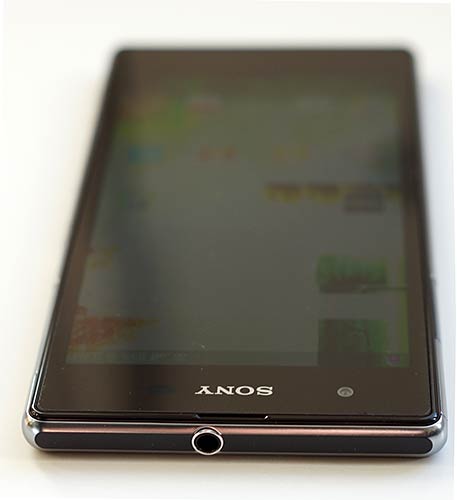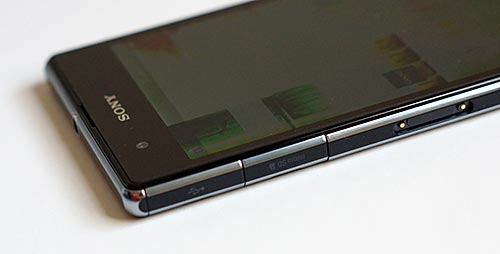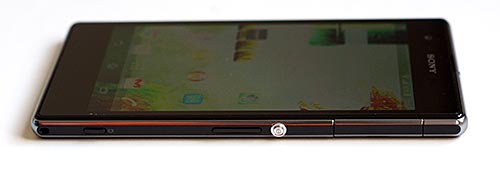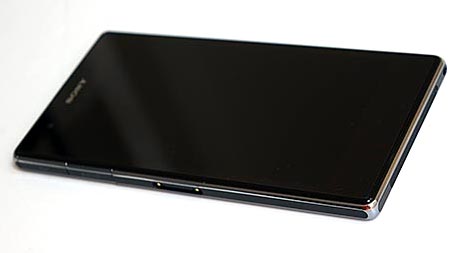Calling and Data
The Xperia Z1S is the T-Mobile US version of the Z1, thus it has worldwide quad band GSM and EDGE with support for T-Mobile's 3G HSPA+ and 4G LTE bands. The phone has pentaband 3G (850/900/1700/1900/2100MHz) and LTE on bands 4 and 17. That means it will work on both GSM and 3G in most places in the world, but only on T-Mobile for LTE (note that you'll have to get an unlock code if you wish to use another carrier's SIM card). Data speeds will of course vary depending on coverage in your area. Here in Dallas, Texas, T-Mobile recently rolled out wideband LTE (20 + 20MHz spectrum) for theoretical 150Mbps max download and 50mbps upload speeds. In fact, close to a cell tower beside a T-Mobile store, we actually did get 100.97mbps down and nearly 30mbps up according to the speedtest.net app. Wow! T-Mobile will roll out wideband LTE in some but not all cities, but all major metro regions should have standard 10 or 20MHz spectrum LTE by now.
Call quality is very good on the Xperia Z1S, and both incoming and outgoing voice are clear and full. Speakerphone volume is a bit lower than average while earpiece volume is average. Sony's waterproofing of the earpiece hasn't degraded voice quality or volume, but we suspect it might be to blame for the not terribly loud speaker. Headphone quality is excellent and we really enjoyed listening to music via a decent quality wired headset. Of course you can use Bluetooth wireless speakers, stereo headphones and mono headsets with the phone, and we found audio quality to be good over Bluetooth.
Horsepower and Software
Just as with the Galaxy S4 and LG G2, the current all-star CPU is under the hood. The 2.2GHz Snapdragon 800 quad core CPU with Adreno 330 graphics is currently the best you can get in an Android phone, and it can handle anything you throw at it. 3D games like Real Racing 3, 4K video playback: it's all good. The phone feels fast and smooth in operation with quick app load times and fluid animations.
It helps that Sony's light customization of Android Jelly Bean 4.3 doesn't weigh down the phone, as do the heavier skins and customizations on the LG G2 and Samsung Galaxy phones. In fact, we really like Sony's tasteful and restrained approach to Android. They do add several programs that work hand-in-hand with Sony's various online services, including Album, Movies, Walkman and PlayStation Mobile. Even if you don't use Sony's cloud services or wish to rent/buy movies from them, these are great looking multimedia playback apps with quick access to EQ, locally stored media, cloud media and even native support for network hard drives that act as media servers via dLNA. PlayStation fans will enjoy PlayStation Mobile where you can download some of the same PS Vita and PlayStation 2 games but ported to Android. There's also a PlayStation app with access to your PSN profile, friends list, trophies and a PlayStation 4 second screen feature. It's refreshing that Sony's software additions make the phone more fun and easy to use for multimedia and gaming rather than just adding bloat.
Benchmarks
| |
Quadrant |
3DMark Ice Storm |
AnTuTu |
Sunspider JavaScript Test |
| Sony Xperia Z1S |
21589 |
16,135 (unlimited) |
35,008 |
837 |
| HTC One M8 |
24,527 |
20,896 (unlimited) |
36,087 |
776 |
| Nexus 5 |
8808 |
17,828 (unlimited) |
27,017 |
718 |
| Moto G |
8485 |
2778 (extreme) |
17,396 |
1311 |
| Samsung Galaxy Note 3 |
22,006 |
15,092 (unlimited) |
35,823 |
587 |
| LG G2 |
19,762 |
9803 (extreme) |
32,990 |
823 |
| Samsung Galaxy S4 |
12,276 |
11,601 (unlimited) |
24,776 |
826 |
| HTC One |
12,252 |
11,324 (extreme) |
24,589 |
1155 |
| Sony Xperia Z |
7916 |
6353 (extreme) |
20,403 |
1306 |
| Moto X |
8357 |
6800 (extreme) |
21,377 |
1097 |
| LG Optimus G Pro |
11,994 |
N/A |
18,561 |
867 |
| Samsung Galaxy Note II |
6001 |
N/A |
14,056 |
1052 |
| Samsung Galaxy S III |
5102 |
N/A |
7011 |
1825 |
Geekbench 3: 909 single core, 2832 multi-core
Camera
Here's the star of the show: the 20.7 megapixel rear camera with a relatively large (by phone standards) 1/2.3" Sony Exmor RS sensor and a fast Sony G f/2.0 lens. No, it won't impress Nokia Lumia 1020 owners for sensor size and resolution, but the Xperia's speed will impress Lumia owners. The phone has quick shot times and fast focus times in good light. In a very dim to dark room, focus is slower, but the same is true of most camera phones. Image detail is excellent and noise is held in check with ISO under 400 to 800. Colors are bold and natural and exposure is good, though in intelligent auto mode, it does blow out some highlights in high contrast scenes. Certainly the images are good enough that you'd be hard pressed to tell the difference between images taken with the Xperia Z1S and a 16MP point and shoot.
Today's top Android phones have 13MP cameras and the Samsung Galaxy S4 Zoom (more of a camera than a phone in terms of design and ergonomics) is 16 megapixels. More pixels don't always mean better images, but in this case those pixels mean better 8 x 10 prints or photo frame images and finer detail for larger images used on websites. If you rarely look at your camera phone's photos on anything but your phone, this won't matter. But for those who do use images for websites, photo sharing and playback on larger screens the Sony has an edge.
The camera can shoot 1080p video, but it uses digital image stabilization rather than optical image stabilization (OIS). Few phones have OIS, with the Lumia 1020 and LG G2 being two in that rare club. OIS increases hand motion smoothness more effectively than digital stabilization. That said, Xperia footage doesn't look jerky or jumpy, but we could see some jitter and jumps caused by our less than steady hands.
Sony sets their intelligent auto mode as the default, and it does a good job when the scene is well lit. In dark settings, I found using manual settings reduced image noise, though I suspect average users will be happy with auto mode's results. When in iAuto mode, you won't see lots of settings, but once you select manual you'll get a wealth of settings for shutter speed, ISO, metering, stabilization, white balance and a selection of scene modes. Sony offers additional modes including a background defocus mode to create SLR style bokeh, Info-eye (augmented reality plus 2D and 3D bar code readers), timeshift burst, sweep panorama and picture effects.
The Xperia has a front 2.1MP camera that can shoot 1080p video and yields clear and bright video chat footage.
Battery Life
Like the LG G2, the Xperia Z1S is an "average" size Android phone with a huge battery inside. That translates into excellent runtimes, even with brightness turned up and both LTE and WiFi on and active throughout the day. The 3,000 mAh battery is sealed inside, and we had no trouble making it through the day (8am to 10pm) with moderate to heavy use that included web browsing, HD video streaming for an hour, email, using the GPS for a 30 minute trip, playing music in the background with the display turned off for an hour and playing games for 45 minutes.
Conclusion
It took Sony a few tries to make a flagship Android smartphone that truly has flagship specs, but they've managed nicely with the Sony Xperia Z1S and Z1. The Xperia Z1S has the fastest CPU currently available, all the wireless bells and whistles including WiFi 802.11ac with WiFi calling and mobile hotspot, fast LTE 4G and NFC. Even if viewing angles aren't as wide as the competition, the full HD Triluminos display is one of the prettiest we've seen with very wide color gamut and a luminous look when watching HD movies. The design stands out and the all-glass look is striking. Sure, it attracts fingerprints, but this is one of the few washable smartphones on the market!
Websites: www.sonymobile.com, www.t-mobile.com
Price: $528 full retail, or 24 monthly payments of $22 with approved credit
Related Reviews:
LG G2 Review
HTC One M8 Review
Sony Xperia Z1S vs. LG G2 Comparison Smackdown
Samsung Galaxy S4 Review
Samsung Galaxy S4 Active Review
Sony Xperia Z Review
Sony Xperia ZL Review
HTC One Review
Sony Xperia Tablet Z Review |




|

